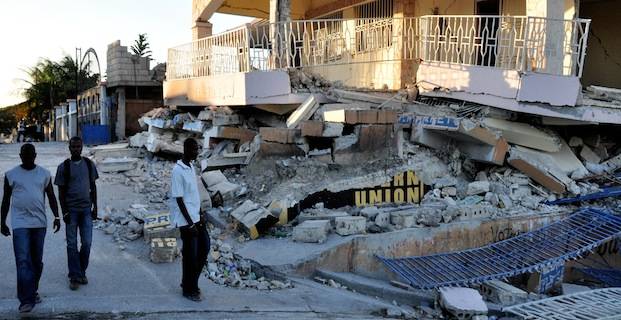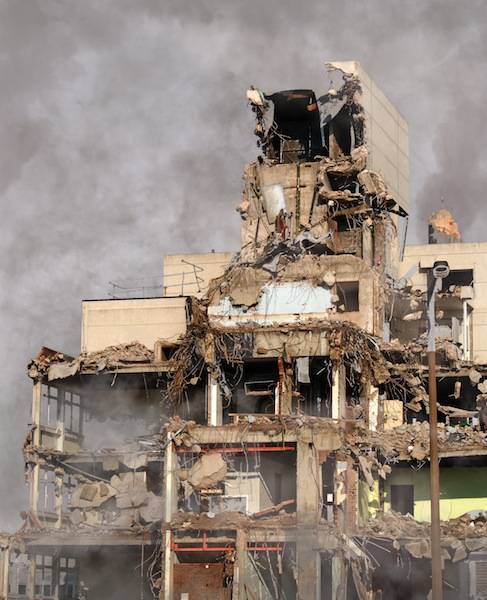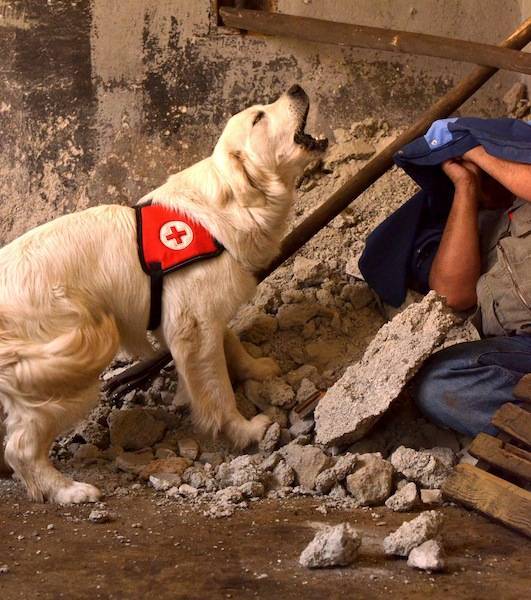Earthquake
Earthquakes, temblors, quakes, tremors: These names are used to
describe the sudden release of energy in the earth’s crust causing
movement.
Firstly, lets get to know some terms that are associated with earthquakes:
Earthquake: A sudden and violent movement of a portion of the earth’s crust, and the series of vibrations that follow.
Earths crust: This is the solid thin layer that covers the
outside of the earth. To put it in perspective, think of it as the skin
on the outside of an apple.
Plate: A plate is a section of the earths crust. Plates slide
along either beside, over or under each other, causing friction and
pressure between the plates.
Magnitude: The amount of energy released during an earthquake, which is computed from the measurement of seismic waves.
Fault: The gaping hole which can occur as a result of an
earthquake. This hole can be the size of a small crack to the size of an
olympic swimming pool or larger.
Fault zones: Where giant rock slabs that are made up of the
earths crust collide and slide against each other regularly, causing the
land to be unstable.
Seismic waves: These waves are the vibrations and movement
that travel from the earthquake fault at very high speeds. The
vibrations of these waves are what cause the most destruction during the
earthquakes.
This gigantic release of energy creates what are known as ‘seismic
waves’. These waves cause the one of the most terrifying and destructive
acts of nature on the planet. These natural phenomena are sudden,
violent shakes of the earth that are caused by the breaking and moving
of the rock in the earths crust as it releases strained energy that has
built up over a long period of time. Earthquakes occur when the energy
has built up so long that is snaps and cause smashing and crashing under
the earths surface and between the plates.
The ‘seismic activity’ of an area holds refers to the frequency, type
and size of earthquakes that are experienced over a period of time.
Frequency means the strength of the earthquake.
Measurements of earthquakes
Measurement of earthquakes are measured using readings from
instruments called seismometers. Scientists use the ‘magnitude rating’
to measure earthquakes. This rating measures the strength of the seismic
waves and the period of time they lasted for. An earthquake measuring
between 3 and 5 on the magnitude rating is considered normal. When they
are between 3 and 5 there usually is not too much damage done, but the
tremors can be felt in the ground. When the magnitude rating is between
the numbers 5 and 7, this is regarded as moderate to strong. Earthquakes
of this magnitude do not cause a huge amount of damage or loss of
lives, but can leave some destruction in its trail, like cracks in the
ground, landslides. Major earthquakes are rated between 7 and 8, and 8
or more is a seriously large natural disaster.
The largest earthquake ever recorded was slightly over 9 on the
magnitude rating. This earthquake occurred in northern Japan in 2011,
killing hundreds of people and destroys buildings within the area. This
earthquake also caused a 23 foot tsunami and was followed by more than
fifty aftershocks.
Earthquakes can cause many other natural disasters once they strike, here are their names and a brief description of each:
- Tsunami – Are giant sea waves that are produced by the sudden violent movement of the earths plates of volcanos under the water. The time periods of these waves can last up to an hour, causing massive devastation as seen in Sri Lanka in 2004.
- Fires – Fires can be caused when earthquakes damage electrical power stations or gas lines. These fires can be impossible to stop sometimes. In 1906 in San Francisco, fire caused by an earthquake killed more people than the earthquake itself.
- Landslides and avalanches – Earthquakes can produce unstable slopes which can lead to the moving of the ground, which is called a landslide. Landslides can cause sever damage after an earthquake occurs, for example it can crash down homes, cars of even people.
- Floods – A flood is an overflow of water that reaches land. This occurs when a lake, dam or river overflows due to the movement of land due to an earthquake or landslide. Floods can have devastating effects on terrain, animal life and human life.
- Human and animal death – Of course, earthquake can cause severe injury and loss of life for both humans and animals. Properties can also suffer, and the collapse of buildings are expected when highly measured earthquakes occur. The aftermath of an earthquake can cause disease and lack of basic necessities for people.
Natural Disaster: Earthquakes
The earthquakes that occur anywhere on the planet that has a large
amount of built up elastic strain energy to push a piece of the earth’s
crust, called a plate. The sides of the fault can move past each other
with no interruption only if there is nothing in the way. If there is
something in the way of the moving plate, this can lead to the formation
of stick-slip behavior. Once the fault gets stuck in a position, the
pressure will build up continuously. This energy will become stored
energy. The energy can be released due to a combination of elastic
strain seismic waves, heating caused by friction of the fault surface,
or cracking of the plate. When one or more of these occur, an earthquake
will be caused.
Earthquake clusters
Most earthquakes form part of a sequence, related to each other in
terms of location and time. The ‘Ring of Fire’ is a rim along the
Pacific Ocean where 80% of the planets earthquakes occur. These
earthquakes are also due to the amount of volcanic activity in the area.
In a 25000 mile horseshoe shape, the Ring of Fire causes a spontaneous
series of faults, volcanic arcs, belts, plate movements and oceanic
trenches. The Ring of Fire contains 452 volcanoes, 75% of which are
active. About 90% of the world’s earthquakes and 81% of the worlds
largest earthquakes occur in this area.
In general when a magnitude of 8 hits anywhere in the world it can
cause a lot of damages and loses. On average around 10,000 people die on
a yearly basis due to earthquake. Most of the human deaths caused by
the result of earthquakes are collapsing buildings. The destruction of
buildings, bridges and historical monuments is often caused by
mudslides, floods, tsunami or fire. The small trembles that occur after a
large earthquake can make rescue operations very difficult and
impossible especially in areas surrounding buildings, bridges etc.
Religious and cultural facts and beliefs about earthquakes:
- In Greek mythology, earthquakes were caused by the god Poseidon. It was believed that when he was in a bad mood, he would strike the ground with a trident and cause many calamities. He would also cause earthquakes to get revenge.
- In Japanese mythology, earthquakes were caused by the thrashing about of a giant catfish that was named Namazu who lived under the earths crust.
- In popular culture, the portrayal of earthquakes is shaped by the memory of cities that were destroyed, such as San Francisco in 1906.



No comments:
Post a Comment